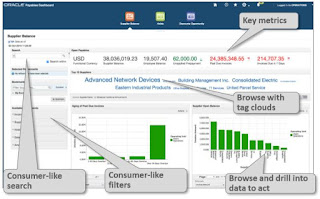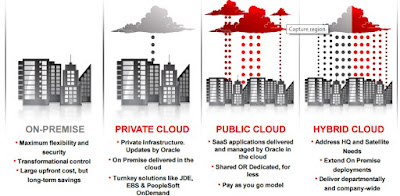Oracle EBS R12 Release Roadmap:
Oracle EBS Release 12.2.5 Highlights
Oracle EBS R12.2.5 Highlights:
Financials:
Value Chain Planning:
EBS Information Discovery: More Products; New Name
Information-Driven Navigation - Powered by Oracle Endeca Information Discovery
Renamed
From: Oracle EBS Extensions for Oracle Endeca

Reference: Note#1983050.1,1934915.1
Oracle has released Oracle E-Business Suite 12.2.5. This latest release continues a pattern of ongoing functional and technical innovation, providing a modern user experience, new functional capabilities across the suite, and increased operational efficiency.
Oracle EBS Release 12.2.5 Highlights
Oracle EBS R12.2.5 Highlights:
Financials:
- GL: Journal Approvals with AME
- Journal approval process integration with Approvals Management (AME)
- Flexible approval rules using:
- HR supervisor hierarchy
- Approval groups
- Dynamic approval groups
- Rules based on new attributes at journal batch, header or line level and other attributes in AME
- AR: Receipt Applications Using Match Score & Knapsack Method
- AP: Transaction Tax Configuration Workbook
- CHRM: Volume Offer Back Dated Adjustments
- Leasing: Enhanced Termination Processing
- Advanced Project Planning and Control - New Product
- Schedule of Values
- Project Mgt: Budgetary Controls in Financial Plans
- Payroll: Enhanced Payroll Dashboard (12.1 RUP8)
- Succession Planning: Configurable Talent Matrix
- Procurement Command Center – New Product
- Integrated command center for procurement professionals
- Procurement Operations: View across document across transaction life cycle
- Indirect Procurement: Analyze requestor feedback, catalog usage, off-contract spend
- Item Analysis: Analyze item history including delivery, quality, and suitability – Supplier Analysis: Analyze supplier history including delivery, quality, and capabilities
- Action Items: Manage tasks across team
- Powered by Oracle Endeca Information Discovery
- iProcurement Information Discovery: Ratings, Reviews and
- Feedback; Catalog Upload via Supplier Network
- Project Procurement: Procurement of Services
- Sourcing: Sourcing Initiatives, Multiple Offers and Alternative Lines
- SLM: Automated Assessments, Dynamic Supplier Lists and Qualification Templates
- Services Procurement: Job Standardization and Rate Changes
- CLM: Contract Deliverable Mgt Across Roles
- Contract Renewal Command Center - New Product
- OM/Pricing: Selling Services Enhancements
- OM/LOG: Flexible Serial Tagging
- OM: Manual Line Splitting of Internal Sales Orders
- OM/CHRM: Enhanced Gross Margin Calculations
- Quoting: Quote Validation Framework
- INV: Receiving Tablet Optimized User Interface
- WMS: Nested LPNs, Zone Picking, Mobile Task Dashboard
- MSCA: Single Sign-On Support
- Outsourced Mfg: CTO/ATO, Internal Toll Mfg, Lot/Serial
- Process Mfg: Outside Processing, Batch Hold Management
- MES: Component Availability Mgt: Day 0 Clear to Build
- MES: Discrete MES Supervisor Tablet Optimized UI
- Map Visualization for Assets and Work
- Linear Asset Management Enhancements
- Asset Creation HTML User Interface
- Service Request Operating Unit Security (MOAC)
- Field Service: Auto Creation of OTL Timecards
- Field Service: High Volume Parts Ordering and Debriefing
- Spares Mgt: Warehouse Shipping Method Calendars
- Spares Mgt: External Repair Execution In-Transit Tracking
- CMRO: Counter Entry and Corrections
- TeleService: Contact Center HTML User Interface
- Field Service: Dispatch Center HTML User Interface
- Service Contracts HTML User Interface
- Data fully secured across Sales, Service, Financials, and SCM applications
- Users in each Operating Unit (OU) can
only access the Service Requests in their
Operating Unit (OU)
Value Chain Planning:
- Oracle Service Parts Planning provides capabilities for automotive and high tech industries.
- A new UI for Oracle Advanced Supply Chain Planning includes mobile support.
The following products are obsolete in Release 12.2.5:
- Oracle Demand Planning
- Oracle Manufacturing Scheduling
EBS Information Discovery: More Products; New Name
Information-Driven Navigation - Powered by Oracle Endeca Information Discovery
Renamed
From: Oracle EBS Extensions for Oracle Endeca
- More product content
- Fixed Assets
- OM: Customer Explorer
- Quoting
- iStore
- Incentive Comp
- CMRO
- Improved the foundation
- Mobile Templates
- Global Search and Quick Links

Reference: Note#1983050.1,1934915.1

























